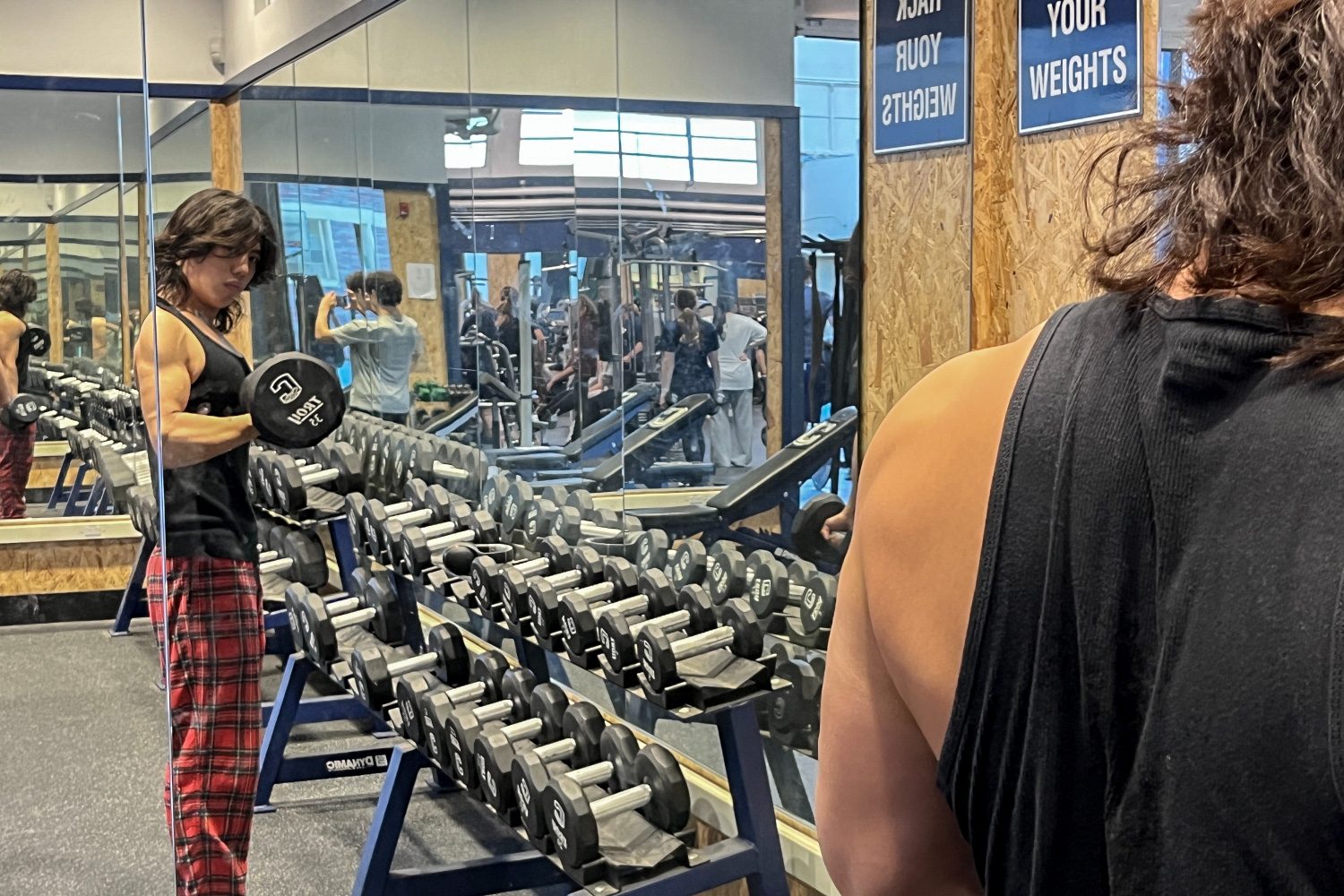
Dysmorphia in the details
Fourty-three percent.
That’s how many men in the U.S. were estimated to struggle with some form of body insecurity surrounding their appearance according to a study published by the National Library of Medicine, a database of scientific literature.
While both men and women were just as likely to suffer from one of the many body-related disorders, men were 22% less likely to report their conditions in comparison to women, according to a study published by Elsevier, a global information analytics company specializing in healthcare.
Though there are a wide range of harmful conditions classified as forms of body insecurity disorders, they share relatively similar symptoms and causes which makes them very difficult to diagnose. Symptoms include multiple types of depression, anxiety, aggression, and drug abuse, according to the Anxiety and Depression Association of America.
“Both pinpointing the factors and causes of these disorders and proper treatment were still active fields of research, so it’s difficult to come to any immediate conclusion,” said psychiatrist Heather Boyle.
However, in recent years, some researchers have made connections between harboring feelings of shame, the stigmatization of the male body through social media, and body insecurity.
This is supported by the percentage of men who struggle with these conditions tripling over the past 25 years, according to the National Library of Medicine
The National Library of Medicine states Body dysmorphic disorder (BDD) is one of the most common of the many conditions associated with body insecurity and causes an intense obsession with a perceived defect in one’s body which leads to an increase in stress and impaired mental function.
Though these symptoms may not seem severe at first, anywhere from 27% to 31% of patients later end up in hospitals, being housebound, and attempting suicide due to BDD.
More recently, psychiatrists concluded that the rise of social media has increased the prevalence of these issues with its promotion of a singular body type for men, according to a study from Liebert Publishing, a leading publisher of health journals globally.
New hypotheses regarding the exact causes of body dysmorphia are emerging as we become more skilled in using fMRI scans and how connections are formed between parts of our brains,”
— Heather Boyle
These conditions formed the harsh reality that 15-year-old Dylan Holoyda faced every time he saw himself in the mirror.

Since his introduction to the world of athletics at the beginning of his middle school years, he has fallen in love with sports. He immediately took up boxing, karate, wrestling, track, and even football, during his high school years.
“I’ve always really enjoyed the competition sports give me, and I’ve been doing them since late elementary,” Holoyda said.
However, it was also around this time in his adolescence when the presence of several serious health conditions made themselves apparent.
“They thought it was anorexia at first, but after getting checked out, they told us I just overproduce stomach acid, though they weren’t sure why,” Holoyda said.
Though his passion for eating allows him to overcome most of the physical symptoms of the condition without much issue, his condition also sparked problems in less tangible spheres.
“Usually, when I go out to eat at a friend’s house or something similar, their parents and other people just assume I’m anorexic and being starved,” Holoyda said. “I’m not really embarrassed, but it’s still annoying.”
From a mental health standpoint, the condition spurred dissatisfaction with his own body, and being diagnosed with both obsessive-compulsive disorder (OCD) and attention deficit hyperactivity disorder (ADHD) only worsened his mental state.

My body didn’t really bother me that much until the doctor started diagnosing me with all these other conditions that hurt my mental health overall,”
— Dylan Holoyda
“OCD and ADHD make it really difficult for me to focus,” Holoyda said. “For example, in class, I have to sit down, take out a little ruler, and sharpen my pencil until it’s the exact length and sharpness I want, otherwise I can’t think clearly.”
The effects of his condition on his daily life also carried over to his pursuits in athletics.
“I always noticed that I was a lot skinnier than all the other kids doing the same sports as I was,” Holoyda said. “It really began to start bothering me around middle school, because it started limiting what I could do; for example, in MMA, they’d only let me spar with the beginners even though I had way more skill because of my weight.”
This feeling of being held back carried over to his time in high school football. Despite being on the team since his freshman year, he felt that expectations were very low for him, thus making it difficult for him to have any real impact on the field due to his physique.
The constant limitations placed upon him due to his body, declining mental health, and immense exposure to far more muscular and “fit” athletes through social media ultimately led him to develop BDD.
“Recently, body image issues have become extremely common due to the uprising of many social media fitness influencers using steroids, looking great, and claiming to be natural,” said Nathan Man, a sophomore at Carlmont High School.

The current ‘fitness fad,’ scrolling especially, makes it extremely easy to compare yourself to the best of the best who dedicate their lives to training, leading individuals to compare and discredit their own progress,”
— Nathan Man
Man is another one of many male athletes like Holoyda who’s dealt with BDD for much of his time in the fitness community.
Though he was initially drawn to the gym to improve his appearance, after his first year and a half of lifting as a bodybuilder, he entered the world of powerlifting and quickly began to attend meets where he’s been showcasing his strength for the past six months.
“I went through a period of horrible body dysmorphia shortly after I started lifting,” Man said. “I began to compare myself to others who were older, stronger, and looked better than me.”
These feelings of inferiority would go on to linger with Man, leaving him with low self-esteem and a sense of extreme self-consciousness. These feelings would spur him to spend three or more hours a day just lifting weights.
“Because I felt that didn’t look good enough, my life began to revolve around lifting; it led to me both dieting and training harder,” Man said.
However, as he developed, he was eventually able to overcome his insecurities.
“I realized that my obsessive comparison to others was detrimental to my mental health, and have realized that progress isn’t linear and that comparison is the thief of joy,” Man said.” Many others go through similar issues where they view themselves as ‘not enough’ and many quit the gym after starting due to those feelings of inferiority.”
Sage Ishibashi-to, a personal trainer and active weight lifter has noticed the increasing rate of body image issues appearing in younger athletes.
“Body dysmorphia and insecurity are pretty common, especially in the generation that’s like a year or two younger than mine,” Ishibashi-to said. “There’s been a resurgence of people wanting to get into the gym, but with a weirdly negative mentality about it. People come to the gym with the mentality of: ‘I need to prove all my haters wrong,’ or whatever rather than just having fun lifting.”
According to Ishibashi-to, this thought process would spawn a variety of dysmorphic and other body image-related issues in those entering the gym for the first time.
Learning to enjoy one’s own fitness journey is something Ishibashi-to mentioned that he believed would benefit many lifters.
Even with the rampant issues of dysmorphia, Ishibashi-to stated “In general, I’ve met some of the nicest people and the most supportive people who go out of their way to help other lifters and just people in general in the gym community.”
He credits this to many gym-goers’ shared experiences getting into fitness as a whole.
“They can all relate to the feeling of being lost as a beginner, so they’re all really welcoming just out of the goodness of their heart,” Ishibashi-to said.
Despite this companionship, a lot of misinformation has been circulating around the fitness industry as of late, according to both Man and Ishibashi-to.
“A lot of social media influencers that are really really big, that claim to be unenhanced lifters are using drugs,” Ishibashi-to said. “It’s a really weird community because I don’t really look down upon steroid use at all, and I have to stay educated on the topic because it’s part of the world that I choose to make my business in, but I feel that if people really understood how much you could achieve with patience naturally, things would be different.”
A lot of guys look down on themselves because they believe they won’t be able to measure up to the top guys in their field, they have to realize that even their idols feel the same way they do as there’s always room for improvement in the gym,”
— Sage Ishibashi-to
He then highlighted specific instances of misrepresentations of steroid use.
“People have been making all these like, like, hyped up videos of like, oh, you know, like, ‘I’m getting such great results on tren,’ yeah, of course you are. It’s an anabolic steroid, and it works,” Ishibashi-to said.
This glorification of the use of steroids would go on to influence many young teens struggling with BDD such as Holoyda and put many others at risk.
“I’ve tried putting on weight, but I don’t gain no matter how much I eat,” Holoyda said. “In the past, I’ve even thought about going on steroids if my condition got worse.”
The popularity of anabolic and androgenic steroids (AAS) exploded in the men’s fitness industry, according to a paper published by Karger, a publication for medical and scientific journals.
The key difference between AAS and other performance-enhancing drugs is that AAS in particular emphasizes increasing muscle growth through superficially boosting testosterone.
Though AAS presents promises of providing one’s ideal musculature, it comes with its share of hefty side effects including hepatotoxicity, organ failure, nephrotoxicity, neurotoxicity, and dementia, and spawns unusually aggressive and violent behavior in its users, according to Karger.
The study also stated that the presence of AAS usage and BDD in male weightlifters were also directly correlated, according to a survey published by Karger, 46% of male weightlifters who used AAS had BDD while only 7% of drug-free male weightlifters experienced any dysmorphia.
A study published by the National Library of Medicine found that nearly 7% of all male high school students with body image problems use some form of steroid during their high school years.
“Most don’t really take into account lifting naturally which is both healthier and not much harder if you dedicate yourself to being consistent,” Ishibashi-to adds.
Ishibashi-to’s claims were far from baseless; according to Karger, male weightlifters with body dysmorphia were 39% more likely to use AAS in comparison to other male lifters.
Ishibashi-to also highlights the business aspect of the explosion of growth in the community from his perspective as a personal trainer.
“People were beginning to realize like, hey, this fitness stuff is a huge industry, and there’s a lot of money to be made here,” Ishibashi-to said. “That desire to make a quick buck off of people has kind of diluted the quality of information.”
He’s also encountered clients who’ve struggled with body insecurity during his time as a personal trainer.
“There’s this powerlifting client of mine, he’s super strong, and I’m really proud of what he’s been able to do in the powerlifting space,” Ishibashi-to said. “But every two months he always hits me with this message, where he’s like ‘Dude, I just want to lose weight so that I can finally get girls again,’ and I’m like, ‘Bro, your ability to get girls is not based on your physique.”
Over the course of his fitness journey, Ishibashi-to’s client has gained 60 pounds and experienced dramatic changes to his physique, so over time, he had associated being much more socially adept with being skinnier and leaner.
Ishibashi-to further elaborated on the significance of his client’s status as a powerlifter.
“Powerlifters can be all shapes and sizes. And they’re kind of like, ‘Hey, if I lift weight then I lift weight, and I’m happy.’ You wouldn’t even consider a lot of them to have a good physique,” Ishibashi-to said.
He said there is a contrast between the pressures powerlifters face surrounding their bodies in with bodybuilders.
“Bodybuilders, on the other hand, tend to struggle with dysmorphia, because their competitive scene is based around a subjective view of how they look,” Ishibashi-to said.
Boyle, like Ishibashi-to, has also had her fair share of clients who’ve struggled with various body image issues such as BDD and anorexia throughout her 15 years as a psychiatrist.
Though body image-related disorders were still an active field of research, so much information surrounding the topic including their causes and treatments was very limited.
“Adolescence is a common period of time that these issues start, as many people with Body Dysmorphia or anorexia notice that bullying is a factor in the development of their illness,” Boyle said.
She also emphasized the impact of modern technology pertaining to the development of body image-related disorders.
“Online bullying that is a part of social media and the video filters available to be used on various platforms are an especially toxic combination for the inciting factors for body dysmorphia,” Boyle said
On the subject of treatments for those struggling with body image disorders, Boyle cites psychotherapy as the most effective means of treatment.
However, this isn’t to denounce other forms of treatment, according to literature published by the National Library of Medicine, methods such as serotonin reuptake inhibitors (SRI) and cognitive behavioral therapy (CBT) have each been shown to improve symptoms of BDD within patients.
SRI medication was found to have improved symptoms in 63% to 83% of patients with BDD, over the course of six months of treatment. In layman’s terms, SRI’s are essentially antidepressants that block serotonin uptake.
CBT is also an effective means of alleviating the symptoms of BDD and has been shown to be just as, if not more effective than anxiety management-centered aid in patients over the course of 16 to 24 sessions.
Though relatively unresearched, clinical evidence also supports the conclusion that utilizing SRI’s in conjunction with CBT would create a more effective means of treatment, according to the National Library of Medicine.
However, due to how niche and unknown much information regarding body image disorders is, she advises spending a lot of time looking for the correct psychiatrist who is not only specialized in body image disorders but also works well with one’s own personal needs.
Ultimately, body image disorders, especially in men, go largely overlooked in spite of their widespread presence which has only grown with the development of social media.
Some warning signs include but are not limited to, escapist behavior, headaches, digestive problems, drug abuse, abusive behavior, irritability, recklessness, drastic mood shifts, and difficulty concentrating, according to the Anxiety and Depression Association of America.
Those who exhibit these symptoms should be immediately referred to 988, the suicide prevention hotline, or any other available helplines with accessible aid to mitigate the chances of their condition worsening.
Despite the severe issues body image disorders pose, they can be overcome with the correct systems in place as seen in Man’s experience.
Even Holoyda, who struggled with a myriad of was eventually able to find a means to alleviate his condition through the sport of track.
“Track just fits a lot better for my body type, and people barely ever mention how thin my frame is,” Holoyda said.



